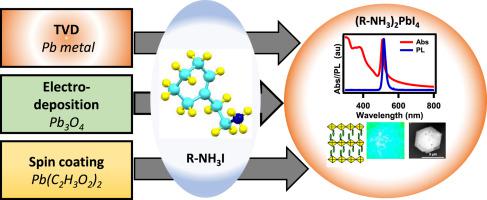当前位置:
X-MOL 学术
›
Opt. Mater.
›
论文详情
Our official English website, www.x-mol.net, welcomes your
feedback! (Note: you will need to create a separate account there.)
Alternative fabrication methodologies for two-dimensional self-assembled Inorganic-Organic hybrid semiconductors
Optical Materials ( IF 3.8 ) Pub Date : 2020-12-01 , DOI: 10.1016/j.optmat.2020.110511 Pawan K. Kanaujia , Kshetra Mohan Dehury , Mohammad Adnan , G. Vijaya Prakash
Optical Materials ( IF 3.8 ) Pub Date : 2020-12-01 , DOI: 10.1016/j.optmat.2020.110511 Pawan K. Kanaujia , Kshetra Mohan Dehury , Mohammad Adnan , G. Vijaya Prakash

|
Abstract This report presents the structural and optical properties of(R-NH3)2PbI4 type Inorganic-Organic (IO) hybrids, prepared from alternative fabrication techniques, without any excess usage of Iodine. The fabrication relies on common deposition techniques viz., thermal vacuum deposition, electrochemical deposition, and spincoating. The resulting two-dimensional (2D) structures are alternatively stacked-up along c-axis by inorganic (PbI6 extended network) layers with organic (R–NH3)- moieties as spacers. These hybrids show strong room-temperature exciton features confined within the lowest inorganic bandgap. The proposed methodologies are simple alternatives to the conventional multi-step fabrication methodologies and are directly applicable to varieties of IO hybrids of different dimensionalities for various optoelectronic applications.
中文翻译:

二维自组装无机-有机杂化半导体的替代制造方法
摘要 本报告介绍了 (R-NH3)2PbI4 型无机-有机 (IO) 杂化材料的结构和光学特性,这些材料采用替代制造技术制备,没有过量使用碘。制造依赖于常见的沉积技术,即热真空沉积、电化学沉积和旋涂。由此产生的二维(2D)结构通过无机(PbI6 扩展网络)层沿 c 轴交替堆叠,有机(R-NH3)-部分作为间隔物。这些杂化物表现出强的室温激子特征,限制在最低的无机带隙内。所提出的方法是传统多步制造方法的简单替代方案,可直接适用于各种光电应用的不同维度的各种 IO 混合体。
更新日期:2020-12-01
中文翻译:

二维自组装无机-有机杂化半导体的替代制造方法
摘要 本报告介绍了 (R-NH3)2PbI4 型无机-有机 (IO) 杂化材料的结构和光学特性,这些材料采用替代制造技术制备,没有过量使用碘。制造依赖于常见的沉积技术,即热真空沉积、电化学沉积和旋涂。由此产生的二维(2D)结构通过无机(PbI6 扩展网络)层沿 c 轴交替堆叠,有机(R-NH3)-部分作为间隔物。这些杂化物表现出强的室温激子特征,限制在最低的无机带隙内。所提出的方法是传统多步制造方法的简单替代方案,可直接适用于各种光电应用的不同维度的各种 IO 混合体。











































 京公网安备 11010802027423号
京公网安备 11010802027423号